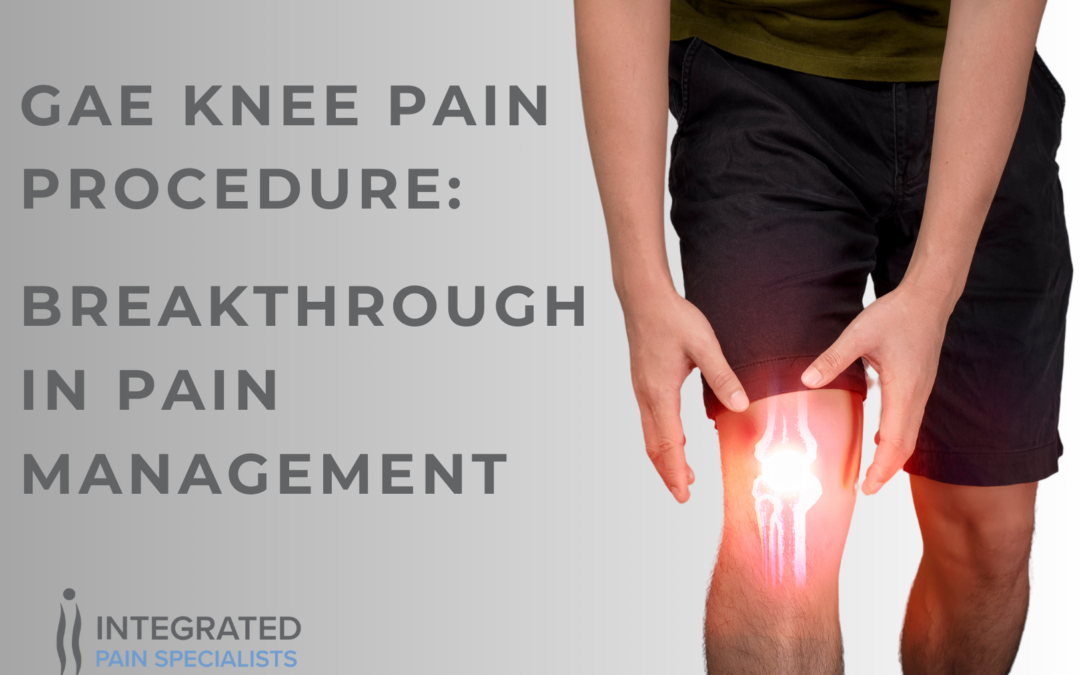Knee pain is a common issue, especially among older adults or those suffering from conditions like osteoarthritis. When traditional treatments fail to alleviate the discomfort, newer, innovative solutions like the Genicular Artery Embolization (GAE) procedure offer significant relief. This article will discuss the GAE knee pain procedure, what it entails, and why it is emerging as a promising option for patients.
Understanding GAE: What Is It?
Genicular Artery Embolization (GAE) is a minimally invasive procedure designed to reduce knee pain by targeting the small arteries that supply blood to the knee joint, known as genicular arteries. This procedure is particularly effective for patients suffering from osteoarthritis (OA) who have not found relief through conservative treatments like medications, physical therapy, or injections.
GAE works by blocking the blood flow to areas of inflammation in the knee. The inflammation in these areas contributes significantly to knee pain in osteoarthritis patients. The GAE procedure lowers inflammation by reducing the blood supply, thereby relieving pain and discomfort.
Who Is a Candidate for GAE?
GAE is recommended for patients who:
- Suffer from chronic knee pain, particularly due to osteoarthritis
- Have not found sufficient relief from other conservative treatments like anti-inflammatory medications or cortisone injections
- Are not yet ready for or wish to avoid total knee replacement surgery
- Are looking for a non-surgical, minimally invasive solution for their pain
The procedure can provide significant pain relief and improve quality of life, particularly for those struggling with advanced stages of OA.
How Does the GAE Procedure Work?
The GAE knee pain procedure is performed by an interventional radiologist under local anesthesia. Here’s what the process typically looks like:
- Imaging: First, an angiogram is conducted to locate the genicular arteries. This is done using a small catheter through a blood vessel, usually in the groin or wrist, to the arteries surrounding the knee.
- Blocking the Arteries: Once the arteries are identified, small particles, known as embolic agents, are injected to block the blood flow to the inflamed areas. These agents prevent further blood flow, reducing the inflammation and pain in the knee.
- Monitoring: The entire procedure is done under imaging guidance to ensure precision and safety. It usually takes about 1 to 2 hours, depending on the complexity of the case.
- Recovery: After the procedure, the patient is monitored for a short period but can typically go home the same day. Recovery time is minimal, with most patients returning to their normal activities within a few days.
Effectiveness of GAE for Knee Pain
Several studies have demonstrated the effectiveness of GAE in reducing knee pain, especially for patients with osteoarthritis. According to research, patients report significant pain reduction, improved mobility, and better quality of life following the procedure. The results are often long-lasting, with many patients experiencing relief for up to a year or more.
While the GAE procedure is relatively new, its minimally invasive nature and effectiveness make it a highly attractive option for those seeking relief from chronic knee pain without undergoing major surgery.
Benefits of GAE Over Traditional Treatments
GAE has several advantages over other knee pain treatments, particularly for patients with osteoarthritis. Here’s why many are opting for GAE:
- Minimally Invasive: Unlike knee replacement surgery, GAE is a minimally invasive procedure. There are no large incisions, and the procedure is done on an outpatient basis, meaning patients can go home the same day.
- Quick Recovery: Recovery from GAE is much faster than traditional surgery. Most patients can return to normal activities within a few days, compared to weeks or even months with knee surgery.
- No General Anesthesia: GAE is performed under local anesthesia, reducing the risks associated with general anesthesia and making the procedure suitable for older or high-risk patients.
- Effective Pain Relief: Clinical studies have shown that GAE provides significant and lasting pain relief for many patients, improving their overall function and quality of life.
- Non-Surgical Option: For patients who are not ready for knee replacement or want to avoid surgery, GAE offers a non-surgical option that can still provide effective pain relief.
- Fewer Side Effects. Since GAE is a minimally invasive procedure, it comes with fewer side effects compared to more invasive treatments. There’s no need for large incisions, and complications are rare.
Potential Risks and Side Effects
Like any medical procedure, GAE does carry some risks. However, these risks are relatively low, especially when compared to more invasive surgical options. Common risks associated with GAE include:
- Bruising or soreness at the catheter insertion site
- Mild post-procedural pain, which is usually temporary
- Rare instances of infection or complications related to the embolic agents
Patients should discuss any potential risks with their doctor to ensure they are fully informed before undergoing the procedure.
What to Expect After GAE
After the GAE procedure, most patients experience significant pain relief within the first few weeks. The reduction in knee pain can last for up to 12 months or more, depending on the individual patient and the severity of their osteoarthritis.
In some cases, patients may require follow-up treatments or additional therapies to maintain pain relief. Physical therapy is often recommended post-procedure to strengthen the muscles surrounding the knee joint and improve overall function.
GAE vs. Knee Replacement Surgery
One of the main reasons patients opt for GAE is to avoid or delay knee replacement surgery. While knee replacement is an effective solution for severe osteoarthritis, it is a major surgery that requires a lengthy recovery period. For patients who are not yet ready for surgery, GAE offers a viable alternative that can provide relief without the need for hospitalization or extensive rehabilitation.
In contrast, knee replacement surgery involves removing damaged portions of the knee joint and replacing them with artificial components. The recovery time can be several weeks to months, and patients may require physical therapy to regain full mobility. While knee replacement can offer long-term relief, GAE provides a less invasive option with a much shorter recovery time.
Conclusion
The GAE knee pain procedure is an innovative and effective treatment option for those suffering from chronic knee pain, particularly due to osteoarthritis. It offers a minimally invasive, low-risk alternative to traditional knee surgeries and has shown promising results in reducing pain and improving patients’ quality of life.
If you’re struggling with knee pain and haven’t found relief through conventional treatments, GAE might be your solution. Consult with the experts at Integrated Pain Specialists, to determine if you’re a suitable candidate for the procedure.

